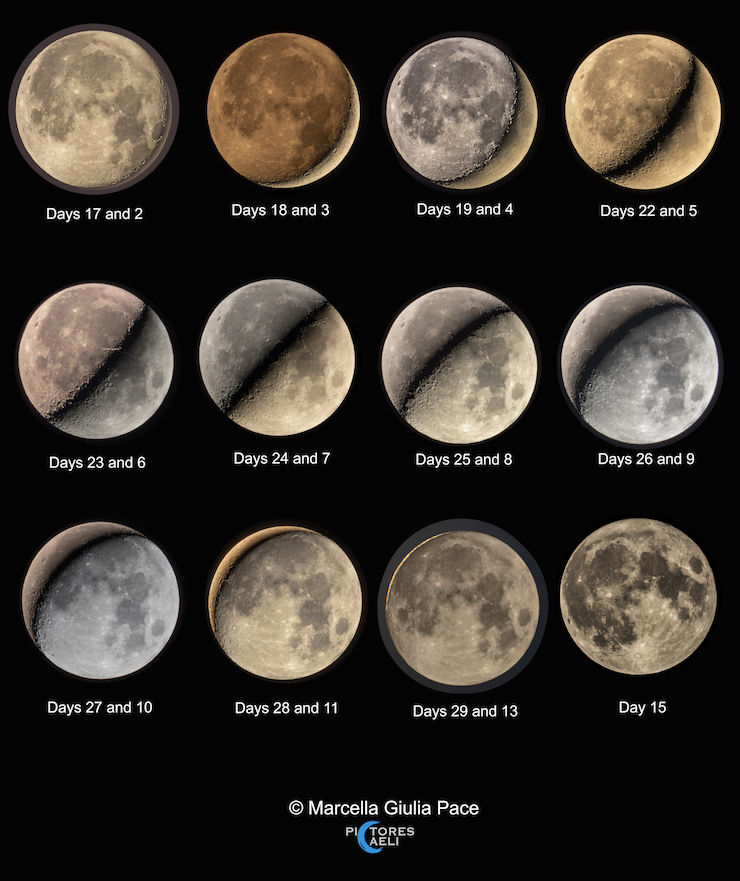
Posted on 09/26/2020 6:50:34 PM PDT by MtnClimber
Explanation: Observe the Moon each night and its visible sunlit portion will gradually change. In phases progressing from New Moon to Full Moon to New Moon again, a lunar cycle or synodic month is completed in about 29.5 days. They look full, but top left to bottom right these panels do show the range of lunar phases for a complete synodic month during August 2019 from Ragusa, Sicily, Italy, planet Earth. For this lunar cycle project the panels organize images of the lunar phases in pairs. Each individual image is paired with another image separated by about 15 days, or approximately half a synodic month. As a result the opposite sunlit portions complete the lunar disk and the shadow line at the boundary of lunar night and day, the terminator, steadily marches across the Moon's familiar nearside. For extra credit, what lunar phase would you pair with the Moon tonight?
(Excerpt) Read more at apod.nasa.gov ...
For more detail go to the link and click on the image for a high definition image. You can then zoom by moving the magnifying glass over an area and then clicking. The side bars will move the zoomed area over the photograph.

Pinging the APOD list.

When the moon hits your eyes like a big pizza pie, that’s amore’.
When all these moons hit your eyes like big pizza pies, it’s heaven in a pizza shop. More amore’.
Notice the gigantic slice of pepperoni at the top!
When an eel lunges out and bites off your snout, that’s a moray...
When the screens are askew, that pattern you view, that’s a moiré...
Day 16 is missing.
...the synodic month, or lunar month, is longer than the sidereal month. A sidereal month lasts 27.322 days, while a synodic month lasts 29.531 days.
|
In a series of experiments, study lead author and graduate student Damanveer Grewal gathered evidence to test a long-standing theory that Earth's volatiles arrived from a collision with an embryonic planet that had a sulfur-rich core.
The sulfur content of the donor planet's core matters because of the puzzling array of experimental evidence about the carbon, nitrogen and sulfur that exist in all parts of the Earth other than the core...
One long-standing idea about how Earth received its volatiles was the "late veneer" theory that volatile-rich meteorites, leftover chunks of primordial matter from the outer solar system, arrived after Earth's core formed. And while the isotopic signatures of Earth's volatiles match these primordial objects, known as carbonaceous chondrites, the elemental ratio of carbon to nitrogen is off. Earth's non-core material, which geologists call the bulk silicate Earth, has about 40 parts carbon to each part nitrogen, approximately twice the 20-1 ratio seen in carbonaceous chondrites.Planetary collision that formed the moon made life possible on Earth | Phys.org | Rice University | January 23, 2019
Saxena stumbled into investigating the early Sun's rotation mystery while contemplating a seemingly unrelated one: Why, when the Moon and Earth are made of largely the same stuff, is there significantly less sodium and potassium in lunar regolith, or Moon soil, than in Earth soil?
This question, too, revealed through analyses of Apollo-era Moon samples and lunar meteorites found on Earth, has puzzled scientists for decades -- and it has challenged the leading theory of how the Moon formed.
Our natural satellite took shape, the theory goes, when a Mars-sized object smashed into Earth about 4.5 billion years ago. The force of this crash sent materials spewing into orbit, where they coalesced into the Moon.
"The Earth and Moon would have formed with similar materials, so the question is, why was the Moon depleted in these elements?" said Rosemary Killen, an planetary scientist at NASA Goddard who researches the effect of space weather on planetary atmospheres and exospheres.Scientists find sun's history buried in moon's crust | Phys.org | NASA's Goddard Space Flight Center | June 17, 2019
There are two explanations for the origins of life's building molecules: extraterrestrial delivery, such as via meteorites, and endogenous formation. The presence of amino acids and other biomolecules in meteorites points to the former.
Researchers from Tohoku University, National Institute for Materials Science (NIMS), Center for High Pressure Science & Technology Advanced Research (HPSTAR), and Osaka University simulated the reactions involved when a meteorite crashes into the ocean. To do this, they investigated the reactions between carbon dioxide, nitrogen, water, and iron in a laboratory impact facility using a single stage propellant gun. Their simulation revealed the formation of amino acids such as glycine and alanine. These amino acids are direct constituents of proteins, which catalyze many biological reactions.
The team used carbon dioxide and nitrogen as the carbon and nitrogen sources because these gasses are regarded as the two major components in the atmosphere on the Hadean Earth, which existed more than 4 billion years ago...
The hypothesis that an ocean once existed on Mars also raises interesting avenues for exploration. Carbon dioxide and nitrogen are likely to have been the major constituent gasses of the Martian atmosphere when the ocean existed. Therefore, impact-induced amino acid formation also provides a possible source of life's ingredients on ancient Mars.Ancient asteroid impacts created the ingredients of life on Earth and Mars | Phys.org | Tohoku University | June 8, 2020

“embryonic planet that had a sulfur-rich core.”
Let it not be overlooked or forgotten “The Venusian atmosphere supports opaque clouds of sulfuric acid” so dense that earth based observations are obscured.
https://en.wikipedia.org/wiki/Atmosphere_of_Venus
[snip] Venus’ atmosphere contains about 96% carbon dioxide, 3% nitrogen, some argon and traces of water vapour (varying from 0.1 to 0.4%), oxygen, hydrogen chloride, hydrogen fluoride, hydrogen sulphide, sulphur dioxide, and carbon monoxide. [/snip]
https://www.eso.org/public/outreach/eduoff/vt-2004/Background/Infol2/EIS-D7_pf.html
Disclaimer: Opinions posted on Free Republic are those of the individual posters and do not necessarily represent the opinion of Free Republic or its management. All materials posted herein are protected by copyright law and the exemption for fair use of copyrighted works.